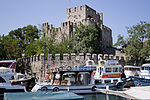Fatih Sultan Mehmet Bridge

The Fatih Sultan Mehmet Bridge ("Sultan Mehmed the Conqueror Bridge"; Turkish: Fatih Sultan Mehmet Köprüsü, abbreviated as F.S.M. Köprüsü), also known as the Second Bosphorus Bridge (İkinci Köprü), is a bridge in Istanbul, Turkey spanning the Bosphorus strait (Turkish: Boğaziçi). When completed in 1988, it was the 5th-longest suspension bridge span in the world. The bridge is named after the 15th-century Ottoman Sultan Mehmed the Conqueror, who conquered the Byzantine capital, Constantinople (Istanbul), in 1453. It carries the European route E80, Asian Highway 1, Asian Highway 5 and Otoyol 2 highways. There are three other bridges that connect Europe and Asia located in Turkey which are named Yavuz Sultan Selim Bridge, 15 July Martyrs Bridge (formerly known as Bosphorus Bridge) and 1915 Çanakkale Bridge.
Excerpt from the Wikipedia article Fatih Sultan Mehmet Bridge (License: CC BY-SA 3.0, Authors, Images).Fatih Sultan Mehmet Bridge
Baltalimanı Hisar Caddesi,
Geographical coordinates (GPS) Address External links Nearby Places Show on map
Geographical coordinates (GPS)
| Latitude | Longitude |
|---|---|
| N 41.0913 ° | E 29.062 ° |
Address
Fatih Sultan Mehmet Köprüsü
Baltalimanı Hisar Caddesi
34470 , Baltalimanı Mahallesi
Turkey
Open on Google Maps







